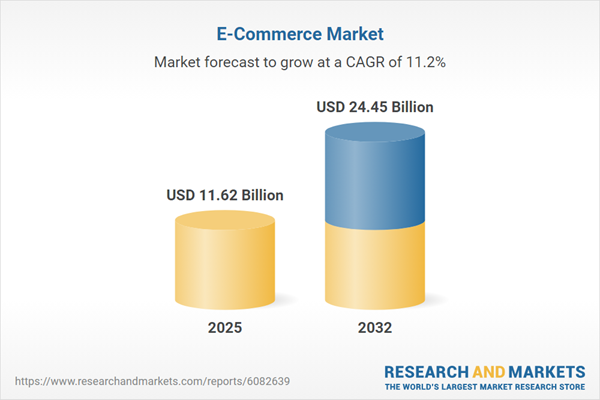Speak directly to the analyst to clarify any post sales queries you may have.
The e-commerce market is rapidly transforming, reshaping how companies across sectors approach digital engagement, supply chain agility, and omnichannel strategies. Strategic decisions in this sector now hinge on deep insights into technology adoption, evolving consumer behaviors, and global regulatory dynamics.
Market Snapshot: E-Commerce Market Size and Growth Outlook
The E-Commerce Market grew from USD 10.46 billion in 2024 to USD 11.62 billion in 2025. It is expected to continue growing at a CAGR of 11.19%, reaching USD 24.45 billion by 2032. This significant market expansion is being shaped by rising online consumer expectations, digital infrastructure advancements, and increased adoption across diverse sectors and regions. Platforms are responding by embedding more sophisticated personalization, seamless transaction capabilities, and robust fulfillment networks, all while managing the complexities of international trade environments.
Scope & Market Segmentation
This report provides a robust strategic framework and actionable intelligence across all key market segments, regions, channels, and technologies:
- Product Categories: Electronics (including computers, tablets, smartphones, and subsegments such as audio equipment, cameras, televisions); Fashion (accessories, apparel—including children's, men's, and women's lines—and footwear); Food & Beverage (alcoholic and non-alcoholic beverages, packaged food, and perishable food); Health & Beauty (cosmetics, personal care, skincare); Home & Garden (furniture, home decor, kitchen, and bath).
- Device Types: Desktop, mobile, tablet.
- Fulfillment Models: Business to business (distributors, wholesalers); business to consumer (multichannel and online-only retailers).
- Channel Types: Direct to consumer (brand websites, mobile apps), marketplaces, social commerce.
- Regions Covered: Americas (including North and Latin America with countries such as United States, Canada, Mexico, Brazil, Argentina); Europe, Middle East & Africa (including United Kingdom, Germany, UAE, South Africa); Asia-Pacific (covering China, India, Japan, South Korea, Australia, and other major markets).
- Major Companies Profiled: Amazon.com, Alibaba Group, JD.com, Shopify, eBay, Pinduoduo, Walmart, Coupang, MercadoLibre, Rakuten Group.
E-Commerce Market: Key Takeaways for Senior Leadership
- Digital storefronts and unified commerce platforms are redefining the customer journey, requiring organizations to synchronize touchpoints and data for competitive advantage.
- Technological investment in AI-driven personalization, headless commerce, and fulfillment automation differentiates agile players and enhances user experience without adding operational complexity.
- Omnichannel retailing is now fundamental as consumers expect seamless experiences across web, mobile, and physical interactions, compelling brands to innovate in data integration and supply chain management.
- Regional differences in regulatory landscape, logistics infrastructure, and digital payment adoption require tailored approaches to market entry and growth strategy.
- Nearshoring and resilient sourcing are gaining precedence in C-suite agendas, especially amid trade policy shifts and evolving tariff structures impacting cost and lead time dynamics.
Tariff Impact: Adjusting Strategies Amidst U.S. Policy Changes
Recent tariff revisions in the United States are prompting e-commerce leaders to reconfigure cross-border supply chains, particularly in electronics, fashion, and consumer goods. Businesses are exploring nearshoring, renegotiating manufacturing contracts, and leveraging scenario-based forecasting to mitigate risk. These adaptations are also influencing inventory management and consumer pricing strategies, with some companies absorbing costs while others increase prices selectively to preserve demand and brand trust.
Methodology & Data Sources
This market analysis integrates comprehensive secondary research from industry publications, corporate disclosures, and regulatory filings with extensive primary interviews from senior executives across retail, logistics, and technology. Consumer input is incorporated through extensive online surveys, supported by transaction analytics and expert advisory panel feedback to ensure reliability.
Why This Report Matters for E-Commerce Decision-Makers
- Enables strategic planning by benchmarking technology, fulfillment, and channel innovations shaping the e-commerce sector.
- Provides actionable risk mitigation insights in response to regulatory shifts and supply chain volatility.
- Equips leaders with segmentation-driven intelligence essential for optimizing customer engagement, channel strategy, and operational investments.
Conclusion
The e-commerce market demands holistic, agile strategies that respond to technology, policy, and consumer shifts. This report offers the roadmap essential for leaders to secure sustainable growth, adapt to regulatory changes, and capitalize on emerging opportunities in digital commerce.
Table of Contents
3. Executive Summary
4. Market Overview
7. Cumulative Impact of Artificial Intelligence 2025
Companies Mentioned
The companies profiled in this E-Commerce market report include:- Amazon.com, Inc.
- Alibaba Group Holding Limited
- JD.com, Inc.
- Shopify Inc.
- eBay Inc.
- Pinduoduo Inc.
- Walmart Inc.
- Coupang, Inc.
- MercadoLibre, Inc.
- Rakuten Group, Inc.
Table Information
| Report Attribute | Details |
|---|---|
| No. of Pages | 193 |
| Published | November 2025 |
| Forecast Period | 2025 - 2032 |
| Estimated Market Value ( USD | $ 11.62 Billion |
| Forecasted Market Value ( USD | $ 24.45 Billion |
| Compound Annual Growth Rate | 11.1% |
| Regions Covered | Global |
| No. of Companies Mentioned | 11 |









